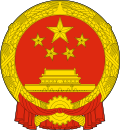Sum (China)
A sum ( Mongolian ᠰᠤᠮᠤ, Cyrillic Сум ), also called Sumu ( Chinese chines / 苏木 , Pinyin sūmù ) in Chinese , is an administrative unit in the People's Republic of China at the municipality level. All of the Sum are in the Inner Mongolia Autonomous Region .
In the late 1990s and 2000s, more and more sums were converted into municipalities and large parishes, and in 2010 there were only 96, but by 2013 the number rose again to 151 sums.
The Sum are located in the predominantly Mongolian populated and cattle-rearing areas of Inner Mongolia and correspond to the communities there . Like the municipalities, the Sum administratively stand above the village or Gaqaa and under the district or banner .
Nationalities sum
A special case is the nationality sum ( 民族 蘇木 / 民族 苏木 , Mínzú Sūmù ). It corresponds to the nationality community ( 民族鄉 / 民族乡 ). However, there is only one example, the Evenk nationality sum ( 鄂溫克 民族 蘇木 / 鄂温克 民族 苏木 ) in the old Bargu banner of the city of Hulun Buir , which increases the total number of sums to 152.
See also
- Sum (administrative division)
- Sum (Mongolia)
- Handagai (example of a sum)
| Mongolian name | |
|---|---|
| Mongolian script : | ᠰᠤᠮᠤ |
| Transliteration: | sumu |
| Official transcription of the PRCh: | sum |
| Cyrillic script : | Сум |
| ISO transliteration : | Sum |
| Transcription: | Sum |
| Chinese name | |
| Simplified : | 苏木 |
| Pinyin : | sūmù |
| Wade-Giles : | su1-mu4 |
